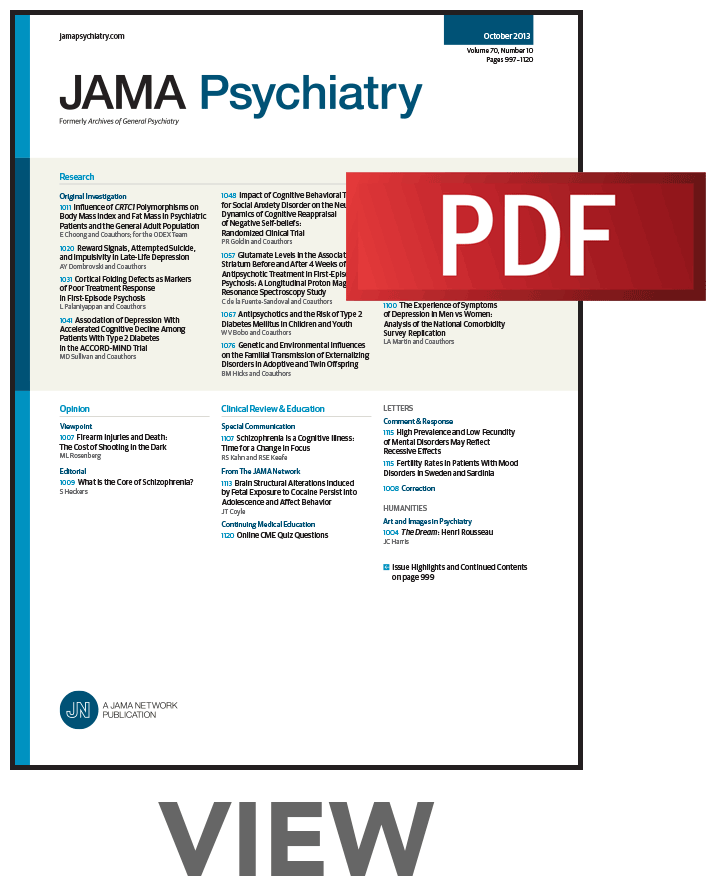Clinical Outcomes of Continuation and Maintenance Electroconvulsive Therapy
IF 22.5
1区 医学
Q1 PSYCHIATRY
引用次数: 0
Abstract
ImportanceLarge-scale evidence for the efficacy of continuation and maintenance electroconvulsive therapy (c/mECT) is lacking.ObjectiveTo provide an exhaustive and naturalistic insight into the real-world outcomes and the cost-effectiveness of c/mECT in a large dataset.Design, Setting, and ParticipantsThis cohort study included all patients in the Danish National Patient Registry who initiated treatment with ECT from 2003 through 2022. The data were analyzed from October 2023 to February 2024.ExposuresECT. An algorithm to identify c/mECTs in the dataset was developed: (>3 treatments with ≥7 and <90 days between adjacent treatments, occurring within a time frame of 180 days [cECT] or more [mECT] after an acute [aECT] series).Main Outcomes and MeasuresThe association of c/mECT with subsequent 6- to 12-month risk of hospitalization or suicidal behavior using Cox proportional hazard regression with multiple adjustments and aECT only as a reference, propensity score matching, and self-controlled case series analysis using a Poisson regression model. A cost-effectiveness analysis based on hospitalization and ECT expenses was made.ResultsA total of 19 944 individuals were treated with ECT (12 157 women [61%], 7787 men [39%]; median [IQR] age, 55 [41-70] years). Of these, 1533 individuals (7.7%) received c/mECT at any time point (1017 [5.1%] cECT only and 516 [2.6%] mECT). Compared with patients receiving aECT only, c/mECT patients more frequently experienced schizophrenia (odds ratio [OR], 2.14; 95% CI, 1.86-2.46) and schizoaffective disorder (OR, 2.42; 95% CI, 1.90-3.09) and less frequently unipolar depression (OR, 0.56; 95% CI, 0.51-0.62). In all models, c/mECT was associated with a lower rate of hospitalization after finishing aECT (eg, 6-month adjusted hazard ratio, 0.68; 95% CI, 0.60-0.78 [Cox regression]; 6-month incidence rate ratio, 0.51; 95% CI, 0.41-0.62 [Poisson regression]). There was no significant difference in the risk of suicidal behavior. Compared with the periods before the end of aECT, c/mECT was associated with a substantial reduction in total treatment costs.Conclusions and RelevanceIn a nationwide and naturalistic setting, c/mECT after aECT was infrequently used but associated with a lower risk of readmission than aECT alone. The totality of the evidence indicates that c/mECT should be considered more often to prevent relapse after successful aECT in patients whose condition does not respond sufficiently to other interventions.持续和维持电休克疗法的临床效果
重要性目前尚缺乏有关持续和维持电休克疗法(c/mECT)疗效的大规模证据。目的通过一个大型数据集,对 c/mECT 的实际疗效和成本效益进行详尽的自然分析。数据分析时间为 2023 年 10 月至 2024 年 2 月。开发了一种算法来识别数据集中的c/mECTs:(相邻治疗之间相隔≥7和<90天的3次治疗,在急性[aECT]系列治疗后180天[cECT]或更长时间[mECT]内发生)。主要结果和测量采用经多重调整的 Cox 比例危险回归、仅以 aECT 为参照、倾向得分匹配以及使用泊松回归模型的自控病例系列分析,得出 c/mECT 与随后 6 至 12 个月的住院或自杀行为风险之间的关系。结果 共有 19 944 人接受了 ECT 治疗(女性 12 157 人 [61%],男性 7 787 人 [39%];中位数 [IQR] 年龄 55 [41-70] 岁)。其中,1533 人(7.7%)在任何时间点接受了 c/mECT 治疗(1017 人 [5.1%] 仅接受了 cECT,516 人 [2.6%] 接受了 mECT)。与仅接受 aECT 的患者相比,c/mECT 患者更常出现精神分裂症(几率比 [OR],2.14;95% CI,1.86-2.46)和分裂情感障碍(OR,2.42;95% CI,1.90-3.09),而单相抑郁症(OR,0.56;95% CI,0.51-0.62)则较少出现。在所有模型中,c/mECT 与完成 aECT 后较低的住院率相关(例如,6 个月调整后危险比为 0.68;95% CI 为 0.60-0.78 [Cox回归];6 个月发病率比为 0.51;95% CI 为 0.41-0.62 [泊松回归])。自杀行为的风险没有明显差异。结论与意义在全国范围内的自然环境中,aECT 后使用 c/mECT 的情况并不常见,但与单独使用 aECT 相比,c/mECT 的再入院风险更低。所有证据表明,对于病情对其他干预措施反应不佳的患者,应更多地考虑使用 c/mECT 来预防 aECT 成功后的复发。
本文章由计算机程序翻译,如有差异,请以英文原文为准。
求助全文
约1分钟内获得全文
求助全文
来源期刊

JAMA Psychiatry
PSYCHIATRY-
CiteScore
30.60
自引率
1.90%
发文量
233
期刊介绍:
JAMA Psychiatry is a global, peer-reviewed journal catering to clinicians, scholars, and research scientists in psychiatry, mental health, behavioral science, and related fields. The Archives of Neurology & Psychiatry originated in 1919, splitting into two journals in 1959: Archives of Neurology and Archives of General Psychiatry. In 2013, these evolved into JAMA Neurology and JAMA Psychiatry, respectively. JAMA Psychiatry is affiliated with the JAMA Network, a group of peer-reviewed medical and specialty publications.
 求助内容:
求助内容: 应助结果提醒方式:
应助结果提醒方式:


